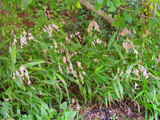Native Plants

Q. Who is Mr. Smarty Plants?
A: There are those who suspect Wildflower Center volunteers are the culpable and capable culprits. Yet, others think staff members play some, albeit small, role. You can torture us with your plant questions, but we will never reveal the Green Guru's secret identity.
Did you know you can access the Native Plant Information Network with your web-enabled smartphone?
Ask Mr. Smarty Plants is a free service provided by the staff and volunteers at the Lady Bird Johnson Wildflower Center.

rate this answer
Saturday - January 05, 2008
From: San Antonio, TX
Region: Southwest
Topic: Grasses or Grass-like
Title: Post freeze care for Texas native grasses
Answered by: Barbara Medford
QUESTION:
Can you tell me the best post-freeze care for Tx native grasses in my garden: lindheimer muhly, gulf muhly, inland sea oats. Mexican feather grass. Do I cut them back? Burn them? Leave them alone? Thank you.ANSWER:
The key word in your question is "native." When you select plants that are already adapted to an area, it cuts down on the maintenance that has to be done. Muhlenbergia lindheimeri (Lindheimer's muhly), Muhlenbergia capillaris (hairawn muhly), Chasmanthium latifolium (Inland sea oats), and Nassella tenuissima (finestem needlegrass) are all native to this area, and will suffer little, if any, from frost. With all grasses, the main concern in trimming is keeping them tidy. It's probably best to leave any dead stems on the grasses until the chances of frost are well over, as the overhanging grasses will help to protect the green part of the plant from an excessive freeze. Then, you might cut about 1/3 of the plant back, and thoroughly rake out any dead or cut ends. Keeping the dead grasses out of the plants is important both to appearance and because the dry material can be a burn hazard. Obviously, we do not advise that you burn anything, especially now with the dry weather in Central Texas, along with high winds.
More Grasses or Grass-like Questions
Weedy buffalo grass from Dripping Springs, TX
March 07, 2013 - I have a buffalo grass lawn. It is thin and filled with weeds. I would like to find a solution to improve my lawn. I prefer a native grass but I need to be able to control the weeds and I am not ph...
view the full question and answer
Plants for area around pool in Plano, Texas
October 13, 2009 - I just built an in ground pool in Plano, Texas and now want to landscape around it on my own. I am curious what plants/shrubs you recommend. There will be plants/shrubs on three sides of the pool. ...
view the full question and answer
Need native plant to stabilize 45 degree slope in Houston, TX.
June 06, 2012 - Can you recommend a native TX plant to be used to stabilize a 45 degree slope in the Houston area? Durability, maintenance and appearance should be considered. Thank You.
view the full question and answer
Arguments for planting native grasses in College Station TX
April 09, 2010 - I hear big ads about putting zoysia grass on my urban lawn but I would rather plant native grass, like Texas Bluegrass (for shady areas) and Blue Grama and Buffalograss grasses. What arguments can I g...
view the full question and answer
Nimblewill grass for a shady area in Dallas
April 04, 2013 - i have a very shady backyard and reading some of your post I think Muhlenbergia schreberi (nimblewill) will survive.
Two questions:
Is it drought resistant?
Where can I buy the seeds?
view the full question and answer
| Support the Wildflower Center by Donating Online or Becoming a Member today. |

